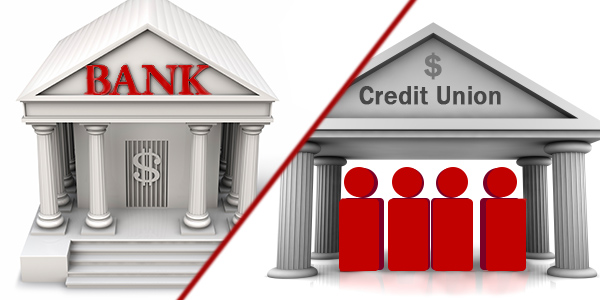Banks and Credit Unions -- What's the Difference?

|
|
Today we have what seems to be a limitless number of options to choose from for our personal finances. Savings and checking accounts, mortgages, and auto loans from various financial institutions are forced upon us every day in the form of advertisements. But which one should you choose, and do you truly know some of the differences between them?
I’m sure everyone knows what a bank is and what it does. But there’s another group of financial institutions out there that don’t get as much TV and radio coverage as banks – credit unions.
You might have heard of credit unions before, but what they are and what they do is still a mystery to some. So, let’s take a closer look and clear things up.
Credit unions are not-for-profit organizations serving a group of members that have a common bond. In plain words, they provides financial services, just like banks, to people that work for a certain employer, live in the same county, state, or region, or worship at a certain place, like a church.
Credit unions offer the same type of financial services you would find at a bank, including checking and savings accounts and various types of secured loans, such as auto, RV, motorcycle, boat, etc. They also offer mortgages, credit cards, and home equity lines of credit, and have online and mobile apps, as well as many other services.
One of the main differences between a bank and a credit union is that credit unions don’t have shareholders who demand profitability and dividends. They are owned by members who have a voice on how a credit union is run — and can express it by either speaking with the leadership directly at any time or more commonly during the annual meeting. Because credit unions aim to serve their members first, they focus on reinvesting their profits back into the organization, often resulting in lower loan rates and lower fees than banks.
Credit unions are very small compared to banks, but have been making progress over the years and are gaining ground in the financial world. A quick glance at bank and credit union assets will give you a better idea on how vastly different they are in size.

You can see that banks overall have roughly $16.2 trillion in assets, while credit unions only have $1.4 trillion. In fact, JPMorgan Chase, National Association, with $2.1 trillion in assets as of Q1 2017, is bigger than the entire credit union industry put together.
Based on regulatory filings, both industries are growing steadily. Although significantly smaller, credit unions gained 7% more assets than banks over the last five-year period. Since 2012, banks grew their asset base by 22.3%, while credit unions pushed forward with 29.3% growth.

Here is a bit more detailed breakdown of the main differences between banks and credit unions.
How Do Banks and Credit Unions Differ?

The bottom line is that banks and credit unions can offer similar, or the exact same, services. It’s up to you to do the homework on fees, interest rates, and branch and ATM locations to make an educated decision in finding the right place for your money.
But keep in mind: We’re here to provide you with safety ratings and data to help you make that decision. So be sure to check out our bank and credit union safety ratings.
Think Safety,
Remi Lukosiunas
Money and Banking Edition, By Remi Lukosiunas, Financial Analyst Remi Lukosiunas, a Financial Analyst, joined Weiss Ratings in 2014 with a financial services background in internal audit and the credit union industry. Remi conducts banking, credit union, insurance and investment research. He has also written extensively on stocks and investing using ratings as a guide. Remi is a graduate of Florida State University with a degree in multinational business. |


